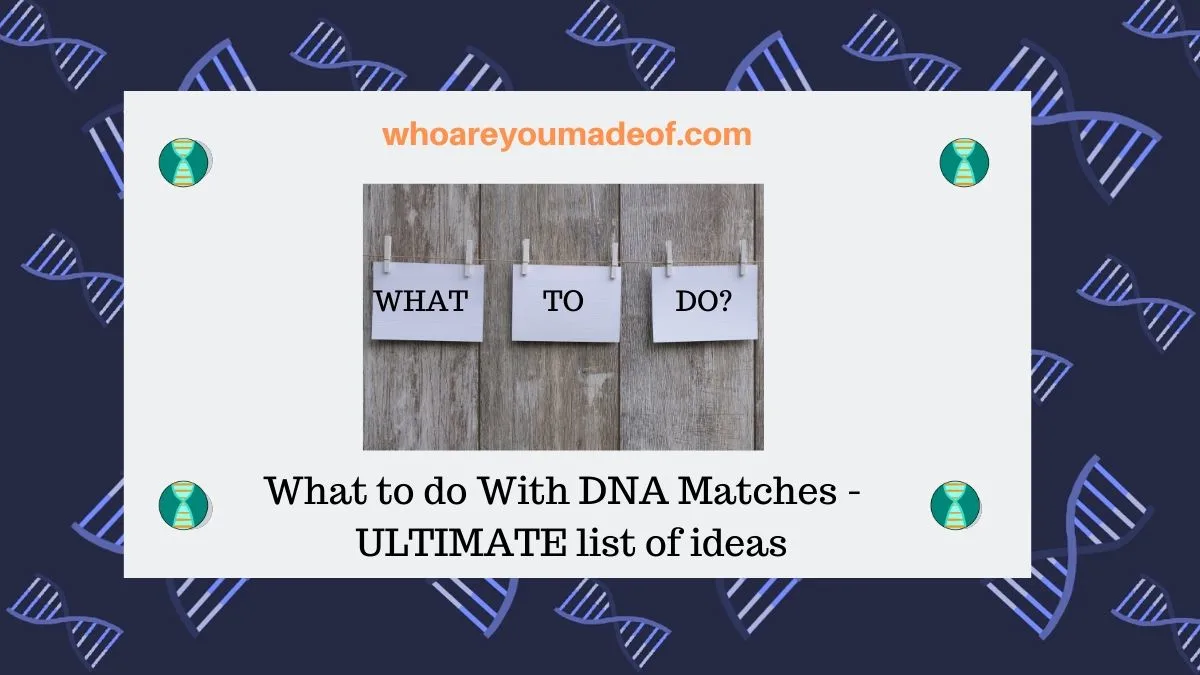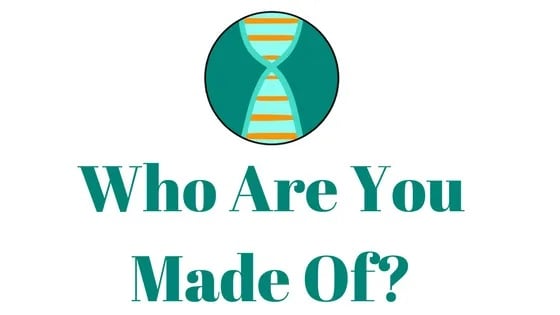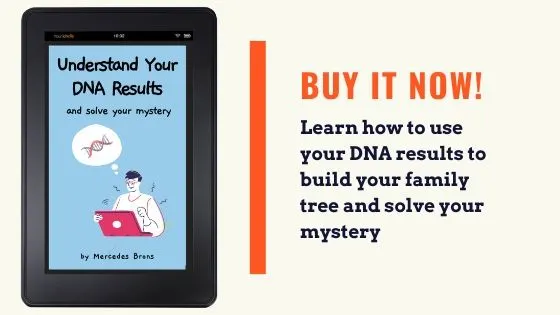If you've just gotten your DNA results back, you have probably seen your long list of DNA relatives, also called DNA matches. What should you do with your DNA matches? What could you do?
In this post, I'll give you the ultimate list of ideas for what to do with your DNA matches. Whether you want to explore your family tree or are just curious about these folks who share DNA with you, you'll find something helpful in this post.

Contact your DNA matches to make new family relationships
One of the easiest and most basic things that you can do with your DNA matches is contact the people at the top of your list.
Your DNA match list is presented to you with the people most closely related to you at the top. Who these individuals are and how they might be related to you could vary based on many factors.
I recommend getting in touch with the top 5 or so DNA matches to touch base. Just say hello and let them know how glad you are to find them and know about them.
Most of the DNA testing companies allow you to contact your matches directly from the DNA match profile page. On Ancestry, you must have a subscription to contact members, so make sure you click the "send message" button from the DNA match profile and not their regular Ancestry profile.
Why you should contact your DNA matches
See if any matches share your surname
Some of your DNA matches might share your surname, or your father's surname.
By finding matches who share your surname, you can trace the trajectory of your father's direct male line back through history, and also around the world.
All of the major companies allow you to search through your DNA results to look for particular names:
- How to filter and sort Ancestry DNA matches
- Tips and tricks for filtering and sorting Family Tree DNA matches
- How to filter and sort My Heritage DNA matches
Contact your DNA matches to learn about your ancestors
Are you interested in your family tree?
Why not contact your DNA matches with the intention of learning more about your shared ancestors?
Then, build a small family tree to keep track of the information that you learn from your matches.
If you want to know what to say when contacting your DNA matches for this reason, this post might help:
Share your DNA match list with relatives
Do you have other family members who are interested in family tree research? They might love to see your DNA match list, and it might inspire them to take their own DNA test.
If your relative has already done a DNA test with the same company that you did, you can give them access to your results directly from your DNA testing account.
If tested with Ancestry DNA, you can allow people who haven't done DNA tests to see your results. All they need to do is create an Ancestry account. Once they do, you can allow them access by following these instructions:
See your shared connections to find which line of your tree you share
While you are checking through your DNA list, why not check to see which matches you share in common with your top 10-15 matches? This can help you determine which line of your ancestry you share with the match.
When I get a new DNA match, one of the first things that I do is check for shared matches. This can help me figure out if the match is related to my mom or dad, and which grandparent the match is likely related to.
For example, if I get a new match and we share my mom's paternal first cousin in common, then I can start my research assuming that this match is descended from an ancestor that my mom's dad (my grandfather) and this new match share in common.
Information learned from shared matches helps you save time when trying to learn the basics of how you might be related to your match.
Sort your DNA matches into groups
While you are digging through your matches, why not organize them?
On Ancestry DNA, you can form groups and assign them different colors. I currently have eight groups which correspond with my eight sets of great-great grandparents.
If you didn't test with Ancestry DNA, don't despair! Each testing company allows you to make notes about your matches (see below) and you can use your notes to order them into groups.
Make notes on each DNA match
Each time you examine a DNA match, it is important to take notes and write them down somewhere safe. Some people choose to keep a notebook where they write details about how they are related to their DNA matches, or information learned from correspondence.
Even if you keep a notebook or a spreadsheet, it's also a good idea to use your DNA testing companies "notes" or "comments" feature to make a quick note about how you think you might be related, whether you've contacted them, and other important details you think you might forget.
The "notes" feature is different than the messaging system. Your DNA matches will not see the notes that you make.
Find out how you are related to all of your top matches
For those who have decided to jump into their match list to learn about how they are related to their matches, and hopefully use that information to build a family tree, I have a specific recommendation:
Set a goal of learning exactly how you are related to your top 15-20 DNA matches.
By doing this, you will verify what you know to be true about your family tree and build your tree out a bit further back.
If you get stumped on a DNA match, you can check out this post with tips to help you figure out how you are related to your matches:
How are you related to your DNA match? Here's a checklist
Use your DNA match list to build your tree
If you have gotten this far in this list, I can tell that you are serious about this whole "DNA match thing" and want to know more.
Did you know that your DNA matches an seriously help you build your family tree? DNA matches are very helpful, especially when combined with more traditional genealogical research.
By examining the family trees of your DNA matches, contacting your matches to learn more, and building your own family tree, you will build your tree bigger and wider in short order.
Check out this post to learn more about using DNA for genealogy:
Map your chromosomes
One of my favorite things to do (yes, I am a serious nerd) is to map my chromosomes and those of my parents.
We inherit one copy of each chromosome from each of our parents. Our DNA matches share segments with specific locations on our chromosomes, and these segments were inherited from the ancestors that we share in common with them.
By "mapping out" our chromosomes and using information that we learn from our respective family trees, we can determine exactly which chromosomes we likely inherited from our ancestors.
This is a relatively advanced topic, but it is something that you can absolutely learn how to do.
I use DNA Painter to map my chromosomes, which I highly recommend. It's easy and fun to use.
Triangulate your DNA matches
If you tested with a DNA testing company that allows you access to a chromosome browser, you can use a cool technique called "triangulation" to find DNA matches who are related to you in the same way.
Chromosome browsers will show you the exact location of shared DNA segments between you and your matches.
Take, for example, a DNA match that shares a 30 cM (centimorgans) segment with you on Chromosome 2. If you know that this DNA match is on your paternal side, you can assume that other paternal matches who also match you at the same location on Chromosome 2 all share the same common ancestor with you on your paternal line.
I use DNA Painter for triangulation and chromosome mapping (called "chromosome painting" on their site). It can seem technical, but it's easier than it looks!
For more information on triangulation and DNA Painter:
Analyze your DNA matches with third-party tools
Have you ever heard of Gedmatch ? It's a really cool (and free!) website that you can use to analyze your own DNA and your DNA matches to learn more about your ancestry.
Plot your DNA matches on Google Earth
You can use Google Earth to plot your ancestors and your DNA matches in order to spot patterns that aren't easy to see on your family tree. I'm hoping that this technique can help me break through some brick walls in my family tree.
I am only just learning about how to do this, so I'll share a link to a video by Lisa Louise Cook that can help you learn how to use Google Earth for genealogy (and plotting those DNA matches!):
So creative!
Check your DNA matches regularly - the list grows!
When I first did my Ancestry DNA test, I only had 43 DNA matches who matches me at a 4th cousin level or closer.
Years later, I now have 925 Ancestry DNA matches! All of the people whose test results I administer have seen their DNA match lists grow, and I know that yours will, too.
This is why I advise everyone to check their DNA match list every once in a while, even if they aren't really interested in researching their family tree.
You never know who you'll find on your list!
Get more DNA matches
If you have gone through this list and are just as excited as I am about your DNA matches, you might be thrilled to learn that you can get more DNA matches without taking another DNA test.
You can download your raw DNA data and upload it to several other sites, many times for free.
Read this post to learn about uploading your DNA to other sites: Free Websites to Upload your DNA
Conclusion
Thanks so much for staying with this post until the end! I hope that it helped you learn all of the different things that you can do with your DNA matches. There is so much to learn!
If you have any questions about something that you read in this post, or if you would like to share an idea that I missed (I can add it!), please join us in the discussion below.
Thanks for stopping by today!


